About President James Buchanan’s Wheatland
Table of Contents
A BRIEF HISTORY OF WHEATLAND | RESIDENTS | WHEATLAND TODAY | VISITING WHEATLAND
A Brief History of Wheatland
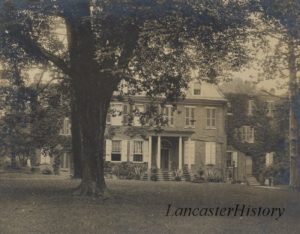
Built by an unknown architect in 1828 for William Jenkins, lawyer and bank president, Wheatland consisted of a mansion and several outbuildings on 156.5 acres of land. The mansion itself was built in the Federal Style of the period, which highlighted symmetry and Greek Revival architecture. The construction is split into three parts that include a center section and two wings on either side. Inside, the mansion has two main floors, an attic, and a basement (which originally housed the kitchen and the wine cellar).
The two surviving outbuildings, also built in 1828, are the privy, and a building that includes the smokehouse and the icehouse. The privy is divided into two rooms, one with five seats at varying heights and one with three seats. The smokehouse and icehouse are found within one outbuilding. The smokehouse is located on the upper level, while the icehouse is located on the lower level and is surrounded by a limestone pit.
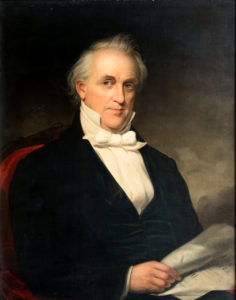
In 1836, Jenkins divided up Wheatland into a plot of 17.9 acres that included the mansion and outbuildings. He sold this tract to his son-in-law, Thomas Potter. Mr. Potter owned Wheatland for several years, during which time he bought an additional 4.4 acres of land from Henry Brenneman.
William Morris Meredith, a Philadelphia attorney, bought Wheatland from Potter in 1845. He paid $6,750 for the property, which included 22.5 acres of land. Just a few years later in 1848, James Buchanan, who was currently serving as Secretary of State under President Polk, purchased the property for the same price. Once he fulfilled his duties as Secretary of State in March of 1849, Buchanan and his “little family” moved into Wheatland.
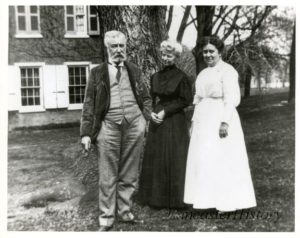
Apart from a few overseas appointments scattered throughout his political career and his time in the White House, Buchanan lived at Wheatland until his death on June 1, 1868. After his passing, his niece, Harriet Lane Johnston, inherited Wheatland and used the home as a summer residence for her family. Following the tragic deaths of her children and husband, she sold Wheatland to the Willson family in 1884.
The Willson family consisted of the following family members: mother Mary Willson, her adult children George B. Willson and Mary E. Willson, and their cousin, Mary Willson Rettew. When Mary E. Willson passed away in 1929, Mary Willson Rettew inherited Wheatland. In 1934, after the death of Mary Willson Rettew, Wheatland was put up for sale once again.
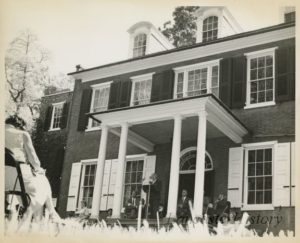
With the intent to preserve Wheatland for future generations, the Junior League of Lancaster raised money to purchase the estate. They raised over $50,000 from the Lancaster community, enabling them to purchase Wheatland and establish a non-profit educational foundation known as the James Buchanan Foundation for the Preservation of Wheatland. Wheatland’s doors officially opened to the public on May 5, 1936. The James Buchanan Foundation for the Preservation of Wheatland would continue to own and operate the home for the next 73 years.
In May 2009, the James Buchanan Foundation for the Preservation of Wheatland merged with its next door neighbor, the Lancaster County Historical Society, uniting the formerly separate historical places and organizations into one non-profit historical and educational institution. The organization, now known as LancasterHistory, continues to make Wheatland accessible to the public through tours and various educational programs.
Wheatland’s Well-Known Residents
Referred to by James Buchanan as his “little family,” the following individuals are among the most well-known residents of Wheatland.
James Buchanan
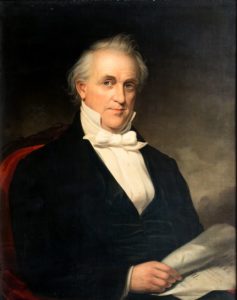
James Buchanan was born on April 23, 1791 to James Buchanan and Elizabeth Speer. He was the second child born out of ten children, and he would go on to outlive all but one of his siblings. Most popularly remembered as Pennsylvania’s only President (until the election of Pres. Joseph R. Biden) and as a lifelong bachelor, Buchanan committed a lifetime to politics. In 1821, he left his law practice and embarked on his political career after having been voted into the U.S. House of Representatives. He would remain in the House for five consecutive terms before serving as the U.S. Minister to Russia, a Senator in the U.S. Senate, the U.S. Secretary of State, the U.S. Minister to Great Britain, and finally, the 15th President of the United States. He died in his bedchamber at Wheatland at 8:30 AM on June 1, 1868. He was 77 years old.
On October 5, 2020, LancasterHistory launched the James Buchanan Presidential Library. The James Buchanan Presidential Library is a digital repository of more than 3,500 items associated with James Buchanan, Harriet Lane, and James Buchanan Henry, extended family members, associates, and Wheatland, Buchanan’s home. Now available and free to access, users can search and view the digitized collection to examine the events that transpired during Buchanan’s presidency and gain a better understanding of how the United States responded to one of the most fraught periods in American history.
Harriet Lane Johnston
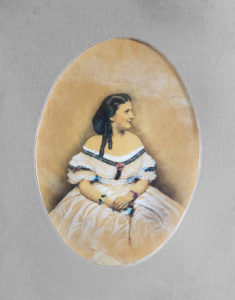
Born on May 9, 1830, Harriet Lane was the youngest surviving child of Elliot Toll Lane and Jane Buchanan Lane. When both of her parents died of consumption, now known as tuberculosis, Harriet went on to be her Uncle James Buchanan’s ward in 1841. A well-educated lady, Harriet attended several boarding schools before graduating from the Georgetown Academy of Visitation Convent at the age of 18. When James Buchanan served as the U.S. Minister to Great Britain, Harriet Lane joined him in London for a time and served as his hostess. During her time in England, which she noted as “the realization of a beautiful dream,” she befriended Queen Victoria. When her uncle assumed the presidency, Harriet Lane assumed her role as White House hostess. She is considered the “first First Lady,” as she was the first person to be given the title of “First Lady” by the American press.
After Buchanan’s presidency, Harriet Lane married Henry Elliot Johnston, a banker from Baltimore, on January 11, 1866. She was 35 years old. The couple went on to have two sons, both of whom tragically died from rheumatic fever in their early teenage years. Two years after losing her youngest son, Harriet lost her husband to pneumonia. By 1884, Harriet was a childless widow. She would go on to leave a legacy for generations to come. Harriet established a children’s hospital in Baltimore called The Harriet Lane Home for Invalid Children (today the Harriet Lane Clinic at the John’s Hopkins Children’s Hospital). She preserved her uncle’s letters and manuscripts. Her impressive art collection became the basis for the Smithsonian American Art Museum in Washington, D.C. She also constructed St. Alban’s School, a school for choir boys attached to the National Cathedral in Washington. Harriet died on July 3, 1903 at the age of 73.
James Buchanan “Buck” Henry
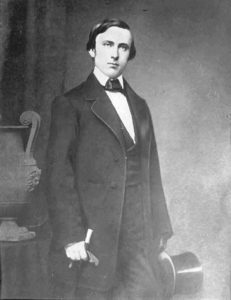
James Buchanan Henry, also known as Buck, was born on March 1, 1833. Just like his cousin, Harriet, Buck lost both of his parents to tuberculosis and was taken in as James Buchanan’s ward in 1840. During his early years, he attended several boarding schools and eventually graduated from the College of New Jersey, now Princeton. Though his real interests were in the arts, Buck went on to pursue a career in law. When James Buchanan assumed the presidency, he called for Buck to join him as his private secretary, a position known today as the Chief of Staff. While Buck worked in Washington, he found himself in frequent conflict with his uncle. This conflict came to a head in 1858 when Buck proposed to his sweetheart, Mary Nicholson. James Buchanan disapproved of the match, causing Buck to leave his position as private secretary after two years in order to marry Mary. The couple would have two children, one of whom would survive into adulthood.
Soon after the birth of their second child, Mary Nicholson died of consumption, leaving Buck a widower. Later on, he married Louisa Anderson, and the two had six sons. After fourteen years of marriage, Louisa died. Buck would marry for a third time much later in his life to a woman named Margaret Grote Elliman. Buck was 71 and Margaret was 24. The two had no children and enjoyed 11 years of marriage before Buck died on February 17, 1915.
Esther “Miss Hetty” Parker
Born on February 25, 1805, Esther “Miss Hetty” Parker was an only child whose mother died when she was very young. While she was being raised by relatives in Roxborough, PA, Esther’s father remarried and had a daughter and two sons in the New Jersey area.
Miss Hetty eventually came to Lancaster to work for her Uncle Edward Parker, who owned the White Swan tavern. While working there, she met James Buchanan, who resided nearby on East King Street at the time. In 1834, Buchanan hired Miss Hetty to work as his housekeeper, a position she would hold for the next 34 years until Buchanan’s death. Traveling with Buchanan and his family from the townhouse on East King Street to Wheatland— and even the White House for a brief period of time— Miss Hetty became a valued family member, assuming the role of hostess, attendant, and occasional nurse. She was always present at the table during gatherings for meals, and, as Buck Henry recalled, was the only person who could scold James Buchanan without rebuke. Buck Henry also noted that her vigilance and wise economy helped maintain Wheatland and grow James Buchanan’s moderate fortune through the years. After Buchanan’s death, Miss Hetty built her own home on West Orange Street in Lancaster City. She returned to Wheatland a few years after Buchanan’s passing to be baptized under the Baptist faith in the freshwater spring on the property. Both Harriet Lane Johnston and Buck Henry were in attendance for her baptism. She died at the age of 94 on February 2, 1899.
Why no image of Miss Hetty? To our best knowledge, no images survive of Miss Hetty. At the most, LancasterHistory does have an image of her sister, Harriet Parker, and can surmise she resembled her sister.
Wheatland Today
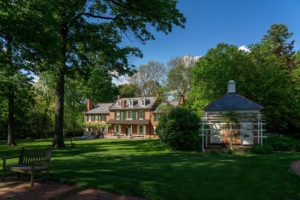
Today, President James Buchanan’s Wheatland is owned and operated by LancasterHistory. Wheatland is at the heart of LancasterHistory’s mission and activities. Wheatland is also a central component of LancasterHistory’s educational and public program offerings, including monthly Special Subject Tours, a Yuletide at Wheatland holiday program, a Presidential Lecture Series, academic symposiums, and student and group tours. Wheatland’s tangible connection to the U.S. presidency, antebellum and Civil War America, and the American political process make it a powerful tool for teaching history to modern day visitors. President James Buchanan’s Wheatland also carries the accomplishments of being a National Historic Landmark (1965) and is listed on the Pennsylvania State Register of Historic Places and the National Register of Historic Places (1979).
Visiting Wheatland
As mentioned above, President James Buchanan’s Wheatland is owned and operated by LancasterHistory as one organizational entity. From January 21 – November 8, 2025, tours of Wheatland will be available Mondays – Saturdays, on the hour, from 10am (first tour departure) until 3pm (last tour departure). Please click here to view any exceptions to those hours.
We encourage visitors to purchase their tickets in advance to guarantee the day and timed tour entry of their choice. Tickets may be purchased online at lancasterhistory.org/tickets. Have questions about logistics and visiting Wheatland? Please check out our FAQ!
Wheatland will be closed to the public from November 9 – 16 as we prepare for our upcoming holiday and history-tour program of the mansion, Yuletide at Wheatland. To learn more about Yuletide at Wheatland and purchase your tickets, please click here. Tickets typically go on sale in October.
If you are unable to travel to Wheatland, we have an exciting Wheatland 360° Virtual Field Trip that is available for free on our website. This tour is perfect Middle School ages and up, and may be of special interest to students and educators, but is available for anyone to view. Similar to Google Street View, you may click throughout the house to explore the different floors and rooms, as well as watch educational videos and view hotspots related to specific artifacts throughout the mansion.
We hope you enjoyed learning more about Wheatland! If you have any additional questions, we encourage you to check out our online Frequently Asked Questions (FAQ) webpage, or contact us at info@lancasterhistory.org or at (717) 392.4633.
